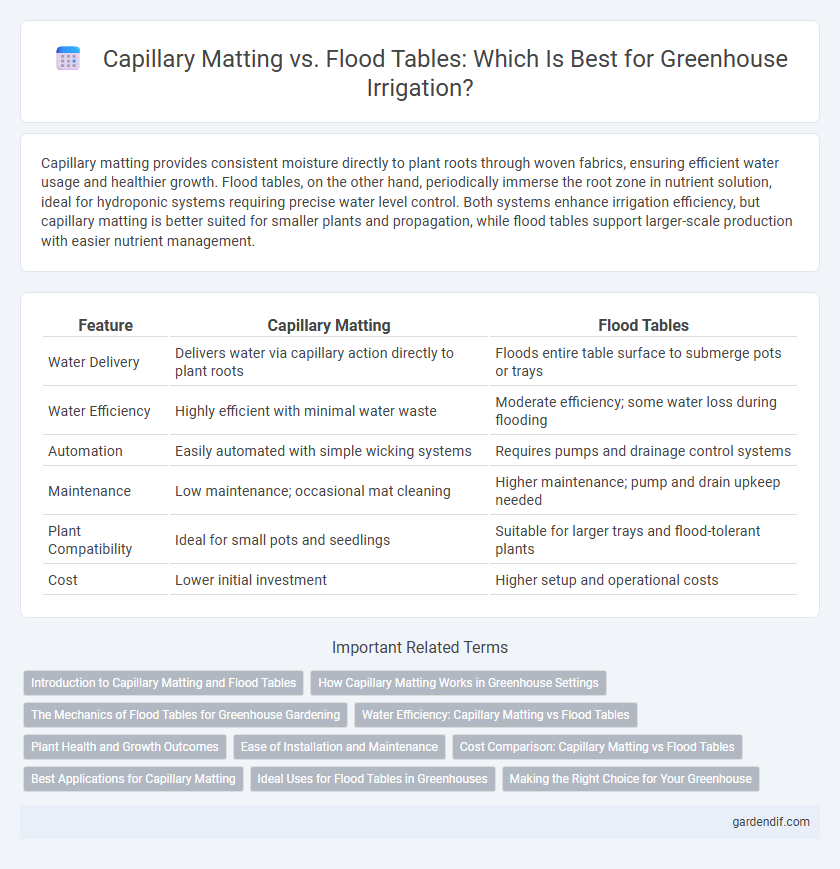
Capillary Matting vs Flood Tables Illustration
Capillary matting provides consistent moisture directly to plant roots through woven fabrics, ensuring efficient water usage and healthier growth. Flood tables, on the other hand, periodically immerse the root zone in nutrient solution, ideal for hydroponic systems requiring precise water level control. Both systems enhance irrigation efficiency, but capillary matting is better suited for smaller plants and propagation, while flood tables support larger-scale production with easier nutrient management.
Table of Comparison
| Feature | Capillary Matting | Flood Tables |
|---|---|---|
| Water Delivery | Delivers water via capillary action directly to plant roots | Floods entire table surface to submerge pots or trays |
| Water Efficiency | Highly efficient with minimal water waste | Moderate efficiency; some water loss during flooding |
| Automation | Easily automated with simple wicking systems | Requires pumps and drainage control systems |
| Maintenance | Low maintenance; occasional mat cleaning | Higher maintenance; pump and drain upkeep needed |
| Plant Compatibility | Ideal for small pots and seedlings | Suitable for larger trays and flood-tolerant plants |
| Cost | Lower initial investment | Higher setup and operational costs |
Introduction to Capillary Matting and Flood Tables
Capillary matting provides efficient water distribution through a porous surface that allows plants to absorb moisture uniformly, making it ideal for seed trays and small pots. Flood tables operate by periodically flooding and draining a flat surface, offering consistent hydration and drainage for larger-scale propagation or container plants. Both systems optimize water use and root health but vary in scale and application based on crop type and greenhouse size.
How Capillary Matting Works in Greenhouse Settings
Capillary matting in greenhouse settings functions by providing uniform moisture to plant roots through a porous surface that draws water via capillary action from a reservoir below. This system ensures consistent hydration, reducing water waste and promoting optimal growing conditions by maintaining a stable water supply directly at the root zone. Unlike flood tables, capillary matting eliminates overwatering risks and improves plant health by delivering precise moisture levels tailored to different crop needs.
The Mechanics of Flood Tables for Greenhouse Gardening
Flood tables operate by periodically flooding a shallow tray with nutrient-rich water, allowing plants to efficiently absorb moisture and minerals through their root systems. This method enhances oxygenation by draining excess water after flooding, preventing root rot and promoting healthier plant growth. Compared to capillary matting, flood tables provide more precise control over watering schedules and nutrient delivery, optimizing greenhouse gardening productivity.
Water Efficiency: Capillary Matting vs Flood Tables
Capillary matting offers superior water efficiency by providing uniform moisture directly to the root zone, minimizing evaporation and runoff compared to flood tables. Flood tables often result in higher water usage due to surface water exposure and uneven absorption, increasing waste and risk of waterlogging. Employing capillary matting can reduce water consumption by up to 30%, making it an ideal choice for sustainable greenhouse irrigation.
Plant Health and Growth Outcomes
Capillary matting promotes consistent moisture distribution directly to plant roots, reducing water stress and enhancing nutrient uptake, which leads to improved plant health and accelerated growth outcomes. Flood tables, while effective for large-scale irrigation, can cause uneven water levels and root oxygen deprivation, potentially increasing the risk of root diseases and inhibiting optimal growth. Choosing capillary matting supports a stable root environment, fostering stronger root systems and higher crop yields in greenhouse cultivation.
Ease of Installation and Maintenance
Capillary matting offers easy installation due to its lightweight, flexible design that simply requires laying flat on benches, minimizing setup time and effort. Flood tables, however, need more complex plumbing and structural support, demanding professional installation and regular system checks to prevent leaks or blockages. Maintenance of capillary mats is straightforward as they are easy to clean and replace, while flood tables require routine inspection of water pumps and drainage systems to ensure optimal performance.
Cost Comparison: Capillary Matting vs Flood Tables
Capillary matting generally offers a lower initial cost compared to flood tables, making it an economically attractive option for small to medium-sized greenhouses. Flood tables, while more expensive upfront due to their complex plumbing and control systems, provide better water efficiency and automated irrigation, potentially reducing labor costs over time. The choice depends on balancing initial investment against long-term operational expenses, with capillary matting favoring budget sensitivity and flood tables supporting scalability and automation in commercial greenhouse operations.
Best Applications for Capillary Matting
Capillary matting excels in consistent moisture delivery for seed germination and propagation in greenhouses, providing a controlled environment that minimizes water stress. Its porous structure allows even water distribution without oversaturation, ideal for delicate seedlings and cuttings requiring steady hydration. This method is especially suited for small-scale cultivation and propagation benches where precise moisture control is critical.
Ideal Uses for Flood Tables in Greenhouses
Flood tables in greenhouses excel in hydroponic and aquaponic systems where precise water level control promotes uniform nutrient delivery to plant roots. Their design supports large-scale propagation of vegetables, herbs, and ornamental plants by minimizing water waste and enhancing oxygen availability. Ideal for crops requiring consistent hydration and efficient drainage, flood tables boost growth rates and yield quality in controlled environments.
Making the Right Choice for Your Greenhouse
Capillary matting provides consistent moisture delivery directly to plant roots, making it ideal for small-scale or sensitive crops in greenhouses. Flood tables offer efficient water recycling and uniform irrigation for larger operations, improving water use efficiency and crop yield. Selecting the right system depends on greenhouse size, crop type, and water management goals to optimize plant growth and resource conservation.
Capillary Matting vs Flood Tables Infographic

 gardendif.com
gardendif.com